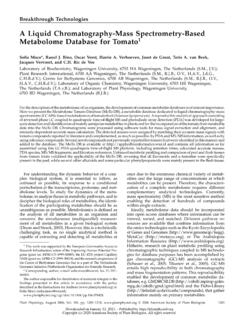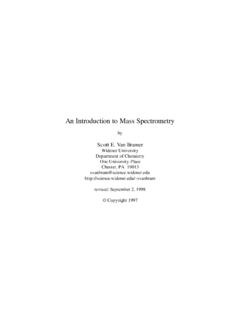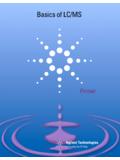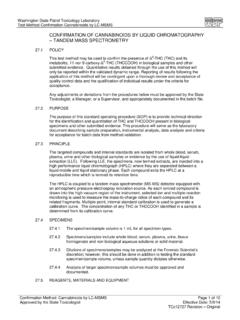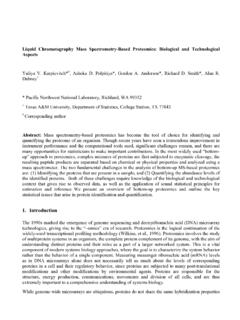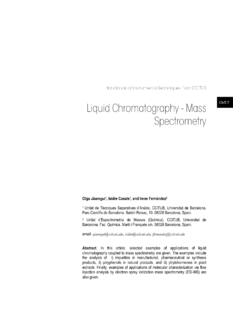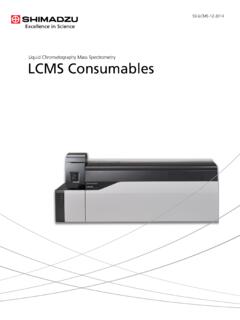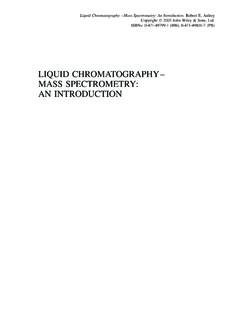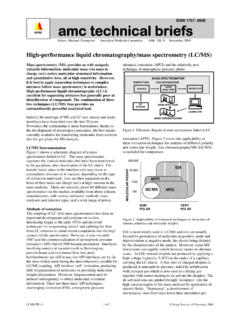Transcription of An Overview of Liquid Chromatography-Mass Spectroscopy ...
1 R ev iew Ar t i cle An Overview of Liquid Chromatography-Mass Spectroscopy Instrumentation Subramani Parasuraman1*, Anish R2, Subramani Balamurugan3, Selvadurai Muralidharan4, Kalaimani Jayaraj Kumar5 and Venugopal Vijayan5. 1. Unit of Pharmacology, Faculty of Pharmacy, AIMST University, Bedong 08100, Kedah, Malaysia. 2. Gulf Pharmaceutical Industries (Julphar), United Arab Emirates. 3. Department of Pharmacology, College of Pharmacy, Madras Medical College, Chennai, India. 4. Unit of Pharmaceutical Chemistry, Faculty of Pharmacy, AIMST University, Bedong 08100, Kedah, Malaysia. 5. Unit of Pharmaceutical Technology, Faculty of Pharmacy, AIMST University, Bedong 08100, Kedah, Malaysia. ABSTRACT. chromatography is a separation technique used to separate the individual compound from a mixture using a stationary and mobile phase.
2 Discovery of chromatography is a millstone event in biomedical research. Chromatographic separation is based on the principles of adsorption, partition, ion exchange, molecular exclusion, affinity and Chirality. There are many types of chromatography available for quantitative and qualitative analysis of pharmaceutical agents, which includes Liquid Chromatography-Mass spectrometry (LC-MS). Combination of chromatography with spectrometry is first reported in 1967 and first LC-MS system was introduced in 1980s. LC-MS is an analytical chemistry technique that combines the physical separation capabilities of Liquid chromatography with the mass analysis and mass spectrometry . Mainly the LC-MS contains Liquid chromatography assembly, ion generation unit/ ionization source, mass analyzer and mass spectrometric data acquisition.
3 LC-MS is most commonly used in biomedical sciences for pharmacokinetic analysis, genetic analysis, structural elucidation, etc. The main objective of this review is to Overview the principle, instrumentation and application of LC-MS. Key words: Analysis, chromatography , HPLC-MS, LC-MS. chromatography Types of chromatography chromatography is a separation technique to separate the 1. Based upon the nature of stationary and mobile phase5. individual compound from a mixture using a stationary and mobile phase. The chromatography word obtained from Gas-solid chromatography Greek, chroma' means colour and graphein' mean writing, Gas- Liquid chromatography hence the word chromatography means colour writing'.1,2.
4 chromatography was first developed by the Russian Solid- Liquid chromatography (column chromatography , botanist Mikhail Tswett' in 1903; he separated coloured Thin Layer chromatography [TLC], High- plant pigments through calcium carbonate ,4 Performance Liquid chromatography [HPLC], Liquid Chromatography-Mass spectrometry [LC-MS]). *Corresponding address: Liquid - Liquid chromatography (paper partition Dr. S Parasuraman chromatography , column chromatography ). Faculty of Pharmacy, AIMST University, Bedong 08100, Kedah, Malaysia. 2. Based on the principles of separation and type of E-mail: chromatographic method DOI: Adsorption chromatography : The mobile ( Liquid Pharmaceutical Methods Vol 5 Issue 2 Jul-Dec 2014 47.)
5 Parasuraman, et al.: An Overview of LC-MS Instrumentation or gaseous) phase is adsorbed into the surface of a Affinity chromatography : This method is most selective stationary solid phase. The separation of the compound and used to separate the antibodies, proteins and enzymes is based on affinity towards stationary phase. The from the biological matrix. It is based on biological compounds which have more affinity with stationary interactions between two molecules, like enzyme and phase will be eluted slowly and compounds with less substrate, receptor and ligand, or antibody and antigen. affinity with stationary phase will be eluted fast. Eg. When a mobile phase containing mixture of proteins/. Column chromatography , TLC, HPLC and antibodies/enzymes are passed through the stationary phase, only the specific protein binds to its respective Partition chromatography : Separation of compounds is ligand in the stationary phase.
6 This protein later can be based on partition of a solute between two In this extracted by changing the ionic strength or form of chromatography a Liquid stationary phase, which is immiscible with the mobile phase, is adsorbed to the Chiral chromatography : This kind of chromatography surface of the solid adsorbent. chromatography is carried used to separate optical isomers (levo and dextro forms). out as described for adsorption column chromatography . of the Partition of component of sample between the mobile 3. Based on different type of analytical method phase (sample) and stationary phase ( Liquid on solid support) retards the elution of some components of Capillary electrophoresis sample which gives the basis for separation.
7 chromatography with conventional detectors Ion exchange chromatography : The principle involved for this method is reversible exchange of ions, Gas chromatography (GC). between the ions present in the solution (mobile Liquid chromatography phase) and ion exchange resin (stationary solid phase). Super critical fluid chromatography This method can be further classified as cationic exchange chromatography and anionic exchange Hyphenated techniques ( mass - spectrometry ). GC-MS and GC-MS/MS. Molecular exclusion chromatography : It's otherwise LC-MS and LC-MS/MS. called as gel permeation or gel filtration. This method is used to separate the proteins, peptides and Supercritical Fluid chromatography -MS (SFC-MS), oligonucleotides on the basis of size.
8 The column is Capillary Zone Electrophoresis-MS (CZE-MS). packed with inertporous spheres (column media). Liquid Chromatography-Mass spectrometry When a mixture of different sized molecules passed through the column, the smaller molecules will enter Liquid Chromatography-Mass spectrometry (LC-MS) or the pores of the spheres (column media) and will take High Pressure Liquid Chromatography-Mass spectrometry more time for elution. On the other hand, the larger (HPLC-MS) is an analytical technique that coupled high molecules could not enter the pores of the spheres and resolution chromatographic separation with sensitive will be eluted and specific mass spectrum detection. This includes High Gradient controller Pump Column Injector Detector Mobile phase Figure 1: Instrumentation of HPLC.
9 48 Pharmaceutical Methods Vol 5 Issue 2 Jul-Dec 2014. Parasuraman, et al.: An Overview of LC-MS Instrumentation Figure 2: Instrumentation of LC-MS. Performance Liquid chromatography (HPLC)-MS, Capillary phase mode of adsorption. Normal phase constricts with Electrophoresis (CE)-MS and Capillary Electrochromatography polar stationary phase with non-polar solvent/mobile phase (CEC)-MS. The combination of Gas chromatography and and reverse phase constricts with non-polar stationary mass spectrometry (MS) was first reported in 1958 and made phase with polar solvent/mobile phase. Normal phase available commercially in Combination of LC with MS mode not widely used in biomedical research and not is an important development in the history of chromatography advisable for pharmaceutical applications since most of (1980s).
10 mass spectrometry in LC-MS helps to determine the the drug are polar in nature and takes longer time to be elemental composition and structural elucidation of a elute and detected. Reverse phase mode have wide range of pharmaceutical application. Examples for reverse phase Principle of LC-MS. columns are octadecylsilane (ODS)/ C18,C8,C4, etc. Typical LC-MS system is combination of HPLC with MS. HPLC Instrumentation using interface (ionization source) (Figure 1). The sample is separated by LC, and the separated sample species are Mainly HPLC instrument contains pump, mixing unit sprayed into atmospheric pressure ion source, where they (solvent degassing system), injector (manual/auto), guard are converted into ions in the gas phase.
